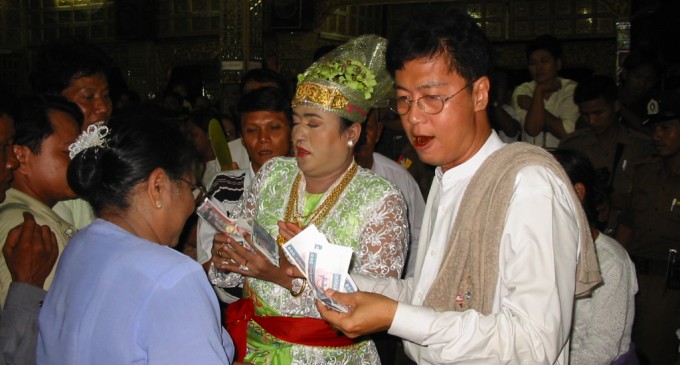The taungpyone nat festival

“The maiden’s Taungpyone Festival is around the corner;Let me accompany with the Myoma musical band to the Festival;’Hey, brother-in-law’, someone is cracking a joke from behind;Be patient, fair maiden, it’s a custom, indeed;’Fair one, hurry back to your home,the toddlers are crying’, jests another.”
From: Pyoh Taungpyone (A maiden’s Taungpyone)
A popular song in Mandalay
Myanmar is a land of pagodas, legends, and myths. In the long span of the nation’s history, almost all the Myanmar great kingdoms flourished and ended in the heartland, and so in a general sense there is stronger pull of tradition and folklore in Anyar or Upper Myanmar. And like elsewhere, along the path of country’s cultural development, elements of folklore and legend have blended into the forms of daily worship of the people.
Look into the home of every Myanmar, and you will find a small shrine in its proper place other than the holiest room reserved for the Image of Lord Buddha. Moreover, in the rural areas where the majority live you will see little shrines beside ponds, under large shady trees and even within the compounds of some monasteries and pagodas. Everyday actions of the common people, may be subconsciously or unconsciously, are shaped by their beliefs, and these small shrines manifest the undercurrent of folk worship finding expression in various forms of piety.
The Locale
About nine miles north of the Mandalay Hill lies the small Taungpyone village nestling quietly among the green fields. In the east are the hillocks, then the cliffs which recede into the blue rolling mountains of the Shan Highlands; in the west is the Ayeyarwady river with brown barren hills of Minwun range forming the backdrop. And in the village stands a small pagoda bearing testimony to the incidents of yore and to the lives and love of the two young princes of Bagan era.
The small village is a perfect setting for whatever you care to call it — folklore, myth or history. Taungpyone area is one of the original places of settlement of the Myanmar tribes, and it has deep roots in the past. According to one school of historical thought this riverine land area called Tonplun Kharuin was the northern advance-post of Myanmar facing Nanchao and Tagaung in the north. In 1110 AD, near the end of the reign of King Kyansittha the last Nanchao invasion was met and defeated here in this area.
Two Strangers
Oral tradition has it that two young Indian brothers, probably after a shipwreck, landed somewhere on the coast of Lower Myanmar at the time of Bagan period. Clinging to a circular piece of flotsam, the two brothers were known as Byat Wi and Byat Ta, the names being derived possibly from Byat which in native tongue means the circular tray, and in this case the lifesaver for the two strangers.
After being cared for by a monk the two young brothers by happenstance came to possess miraculous physical powers when they ate the flesh of a dead Zawgyi or alchemist, whose sweet-smelling shell of the corpse was the size of a young baby. The elder brother Byat Wi was involved in a love affair at Thaton or Thuwunnabumi that led to his tragic death, so his younger brother Byat Ta escaped to Anyar or Upper Myanmar where the great king Anawratha was on the throne. While serving the daily duty of offering flowers to the King of Bagan, Byat Ta fell in love with Mei Wunna, the flower eating ogress, at Mount Popa. She bore him two sons, Shwe Phyin Gyi and Shwe Phyin Kalé, who in time became dashing young courtiers of the court.
Knocking the Steely Heart
Taungpyone was a breadbasket for our ancestors, and it is still handing down its fertility to the present. Now, the villagers are mostly cultivators, and to augment their income fish ponds are also raised. Shwe Phyin Kalé, the more aggressive younger one, had a crush on a village beauty named Mei Oo, whose husband was far away plying the timber rafts. Working daily at her hand-loom, she waited patiently for her beloved husband, but instead came the wild advances of Min Kalé. In the end, however, the young prince found himself knocking in vain the steely heart of the virtuous Mei Oo. After tragedy hit them both in their lives they became Nats or spirits sitting pretty in their own domains.
The Two Missing Bricks
When you enter the Taungpyone Hsu Taung Pyae (Wish-Fulfilling) Pagoda from the eastern entrance, you will find a hollow space for two missing bricks overhead in the inner side of the arched entrance to the chamber of the Image of Lord Buddha. When King Anawrahta built this pagoda he ordered all his courtiers to contribute a brick each to his royal merit; the two princes, however, seemed to be away on their escapades.
Consequently, the two wayward brothers failed to contribute the two bricks in time, and the King ordered that the two young brothers were to be duly punished. But the royal underlings, perhaps with a touch of overkill, threw the book at the two brothers by executing them. And they became the powerful Nats or spirits. The event bears a painful testimony to the tragic lives of the two princes.
The Festival
Come the month of Wagaung (August/September) every year, the streams and rivers are swollen. Overhead the sun and the clouds play hide-and-seek as the hot humid breeze blows in from the south. The little village becomes alive as it holds the week-long annual pagoda festival of Hsu Taung Pyae, commonly known as Taungpyone Nat Festival. And the nearest point of eminence from where you can watch the faithful and the revellers coming to pay respects is from the top of the Mandalay Hill where you can also enjoy a bird’s eye view of the whole flat plain.
At the height of the festival a long line of vehicles ranging from delux saloons to World War II vintage buses move haltingly along the narrow road that leads to the village. Revellers, some on the roofs of various vehicles and some at the back foot-boards, crack jokes at each other hurling such homespun epithets: mother-in-law at the elderly women, brother-in-law at the young men and at the fair maidens — how come they visit the festival leaving the crying toddlers behind.
The Nat festival reaches the climax on the fourth day when the faithful observe the bathing ritual of the two Nat princes; in the past the nearly life-size statues of the princes were carried on palanquin followed by a train of procession to the Shwe Ta Chaung stream (the Golden Stream) which runs close to the west of the village.
Starting from that fourth night the propitiation ritual dances, accompanied by Natchin ritual songs, are performed throughout the night. The true believers convey their wishes through the spirit-mediums who dance in front of the statues in various state of abandon, trance, and possession. Some light-hearted revellers, perhaps spurred on by the influence of liquor and by the wild rhythms of Nat music, mimick the spirit-mediums frolicking in their own rapture.
Adjacent to the shrine of the two princes are the makeshift booths of the spirit-mediums with various Nat figurines on the shelf where the faithful come to place their offerings and to hear the spirit-mediums read their future. Around the outer precincts of the pagoda are the food stalls, shops displaying their local wares and Zat Pwe (song and dance troupes) entertainment serving the visitors throughout the night.
Taungpyone is arguably the biggest Nat festival in the country, so the faithful make it a point to attend the festival annually from wherever they are at that time. And on the last day of the festival, the Fullmoon Day of Wagaung month, the beautiful moonlit night is matched by the mood enveloping the revellers, and when dawn breaks in the eastern horizon the small village again sinks back into its quiet routine.
Times change, and modern life becomes more and more complex yet the simple faith in these two princes of distant Bagan era makes the faithful come every year with renewed hopes and wishes. After all, in our everyday lives don’t we often live by emotion rather than reason?
Yay Chan (Mandalay)
./wp-content/uploads/2018/10/Emirate-Online-TDY.png)
















There are no comments at the moment, do you want to add one?
Write a comment